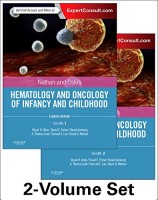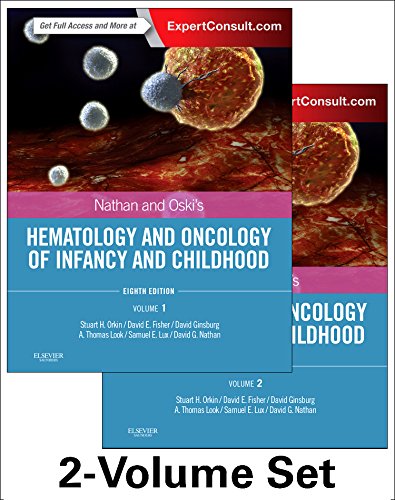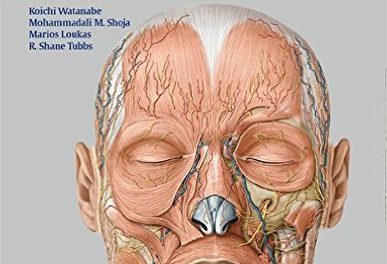 Editors: Stuart H. Orkin, MD; David E. Fisher, MD, PhD; David Ginsburg, MD; A. Thomas Look, MD; Samuel E. Lux, MD; and David G. Nathan, MD.
Editors: Stuart H. Orkin, MD; David E. Fisher, MD, PhD; David Ginsburg, MD; A. Thomas Look, MD; Samuel E. Lux, MD; and David G. Nathan, MD.
Publisher: Elsevier Saunders – 2535 pages, plus Index
Book Review by: Nano Khilnani
This eighth edition of a book that began about four decades ago has become a classic in its field. It is an essential resource for students and practitioners, as well as for basic and clinical investigators, on the pathophysiology of diseases common to children, especially those related to the blood (hematology) and cancer (oncology).
One hundred eighty physicians and surgeons, professors and medical investigators and other experts from the United States and these countries – Australia, Canada, Denmark, Egypt, Ireland, Italy, the Netherlands, Spain, and the United Kingdom – authored the 74 chapters of this massive, two-volume book. The chapters are organized around the 16 sections enumerated below. The first volume centers around disorders relating to the blood and the second one on cancer.
Volume 1
- Neonatal Hematology
- Bone Marrow Failure
- Disorders of Erythrocyte Production
- Hemolytic Anemias
- Disorders of Hemoglobin
- Phagocyte System
- Immune System
- Storage Diseases
- Hemostasis
- Supportive Therapy
- Hematologic Manifestations of Systemic Diseases
Volume 2
XII Biology of Cancer
XIII Pediatric Cancer Therapeutics
XIV Hematologic Malignancy
XV Solid Tumors
XVI Supportive Care
Appendices: Reference Values in Infancy and Childhood
In addition to information available in its over 2,500 printed pages, you can also access material online. The contents of this book, like most other Elsevier books, are available anytime, anywhere online. Enhanced eBooks from Elsevier Publishing for medical professionals are compatible with the PC, Mac, most mobile devices, and eReaders. Expert Consult allows you to browse, search, and interact with this title – online and offline.
To get access to the contents of this book and other information online, first redeem your PIN from the inside front cover of the book. Here’s what you do:
- Login or Sign Up at www.ExpertConsult.com
- Scratch off the gray stickler on the inside from cover to get your PIN code
- Enter PIN into the Redeem a Book Code box at the above website
- Click Redeem
- Go to My Library
Once you have logged in, these are the innovative features available to you online:
- Seamless, real-time integration between devices
- Straightforward navigation and search
- Notes and highlights sharing with other users through social media
- Enhanced images with annotations, labels, and hot spots for zooming on specificdetails*
- Live streaming video and animations*
- Self-assessment tools such as questions embedded within the text and multiple-format quizzes. *Some features vary by title
You can get even more valuable information from an allied website – www.ClinicalKey.com. This search engine of Elsevier Saunders is specially designed for doctors by providing them:
- Comprehensive Content – the most current, evidence-based answers available for every medical and surgical specialty.
- Trusted Answers – content supplied by Elsevier, the world’s leading provider of health and science information.
- Unrivaled Speed to Answer – faster, more relevant clinical answers, so you can spend less time searching and more time caring for your patients.
At the beginning of this book, you will find 15 pages of acronyms commonly used in this medical specialty. In the course of practice, these shortened terms relating to various conditions are used. Some are common while others are not as frequently used.
The chapters provide you a large volume of information, but they are not as intimidating as you might fear because the materials are organized in a highly streamlined way, and consistently in every chapter. You will find almost all the terms used in a given chapter on its first page in a compact Chapter Outline.
In bold all-caps letters, the main topics are laid out and discussed, with visual features used to help you understand the materials in less time. Some of the types of these features are:
- Biopsy images
- Boxes
- Charts
- Diagrams
- Drawings
- Figures
- Illustrations
- Mathematical formulas
- Micrographs
- Schematics
- Scintigraphs
- Tables
A Conclusion caps the basic points covered in each chapter, and a list of Key References at the end provides you numerous opportunities for further study.
Among the benefits of using this book are the following:
- From a definite diagnosis and create the best treatment plans possible with comprehensive coverage of all pediatric cancers, including less-common tumors, as well as all hemotologic disorders, including newly recognized ones.
- Learn about the latest breakthroughs in diagnosis and management, making this the most complete guide in pediatric hematology and oncology.
- Develop a thorough understanding of the underlying science of diseases through summaries of relevant pathophysiology balanced with practical clinical guidance.
- Stay at the forefront of your field thanks to new and revised chapters covering topics such as paroxysmal nocturnal hemoglobinuria, lysosomal storage diseases, childhood genetic predisposition to cancer, and oncology informatics.
- Discover the latest in focused, molecularly targeted therapies derived from the exponential growth of knowledge about basic biology and genetics in the field.
- Visualize clinical problems more clearly with new and updated images throughout.
- Quickly and effortlessly access the key information you need with the help of consistent organization from chapter to chapter and from volume to volume.
- Rely on it anytime, anywhere. Access the full text, images, and more at www.ExpertConsultant.com
This is an extremely useful, indispensable print and online resource on diseases of infants and children relating to the blood and cancer. It is a massive reference source that is well-researched, expertly organized and thoughtfully written.
Editors:
Stuart H. Orkin, MD is David G. Nathan Professor of Pediatrics at Harvard Medical School; and Chairman of the Department of Pediatric Oncology at Dana-Farber Cancer Institute. He is also affiliated with Boston Children’s Hospital, and Investigator at Howard Hughes Medical Institute in Boston, Massachusetts.
David E. Fisher, MD, PhD is Chief of the Department of Dermatology, and Director of Cutaneous Biology Research at Massachusetts General Hospital. He is also Director of the Melanoma Program at Massachusetts General Hospital Cancer Center in Boston, Massachusetts.
David Ginsburg, MD is James V. Neel Distinguished University Professor in the Departments of Internal Medicine, Pediatrics and Communicable Diseases, and Human Genetics; and Investigator at Howard Hughes Medical Institute in the University of Michigan Medical School in Ann Arbor, Michigan.
A Thomas Look, MD is Professor of Pediatrics at Harvard Medical School; and Vice Chairman for Research in the Department of Pediatric Oncology at Dana-Farber Cancer Institute at Boston Children’s Hospital in Boston, Massachusetts.
Samuel E. Lux, MD is Robert A. Stranahan Professor of Pediatrics at Harvard Medical School; and Chief Emeritus in Hematology/Oncology at Boston Children’s Hospital in Boston, Massachusetts.
David G. Nathan, MD is President Emeritus of Dana-Farber Cancer Institute; Physician-in-Chief Emeritus at Boston Children’s Hospital; and Stranahan Distinguished Professor of Pediatrics and Professor of Medicine at Harvard Medical School in Boston, Massachusetts.







